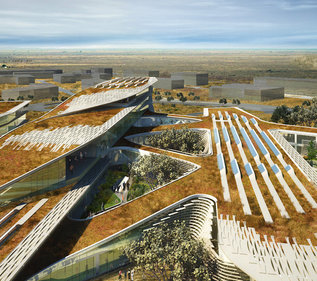OKAVANGO DELTA
Arguably one of the most beautiful places to visit in Africa, the Okavango Delta is actually the world’s largest inland delta. It’s an oasis of islands, wildlife and lush green vegetation located in the middle of the dry unforgiving Kalahari Desert. Make sure you go on a unique a safari tour and spot wildlife from the safety of a traditional canoe (a mokoro) and then camp overnight. SeeSanctuary Retreats for more details.
KALAHARI DESERT
Part of the huge sand basin that reaches from the Orange River up to Angola, this is where vast expanses of sand masses were created by the erosion of soft stone formations. The terracotta dunes have been shaped by wind and have a surreal, other-worldly beauty. Also visit for the Central Kalahari Game Reserve, one of the world’s largest game reserves. It’s not as accessible as the other parks but its remote location ensures it’s far less touristy.
MAKGADIKGADI PANS
Another place with an unearthly beauty is the Makgadikgadi pans, the largest salt pans in the world. Located in the middle of the dry savanna of northeastern Botswana, it’s the remains a huge lake which dried up thousands of years ago. The salt-encrusted pans are flat and arid and come complete with a skyline which appears to go on forever. Camping safaris to spot the resident zebra, wildebeest their predators are a good option for more adventurous travellers.
NXAI PAN NATIONAL PARK
Nearby this national park consists of Nxai Pan, which is one of the Makgadikgadi Pan salt flats. Characterised by sand dunes, vast salt pans, the famous Baines baobab trees it’s a beautiful place which of course offers excellent opportunities to see bird and wildlife. Open all-year round, it’s located in northeastern Botswana so it’s easy to combine a visit with the nearby Okavango Delta and the Chobe.
LINYANTI WILDLIFE RESERVE
One of the most exclusive safari areas in Africa, this place caters to the well-heeled adventurous traveller. The peaceful private reserve covers some 308,000 acres and can be found in the North East of the country. The area is fed by the Kwando River ensuring plenty of wildlife spotting opportunities – it’s renowned for its many Lion prides and also being home to one of Botswana’s largest Elephant populations.
KGALAGADI TRANSFRONTIER NATIONAL PARK
This is a sprawling conversation area which covers over 3.6 million hectares and is known for its red sand dunes and dry riverbeds. It straddles the border between South Africa and Botswana and is an excellent place for wildlife watching. Expect to see predators such as cheetahs, lions, leopards and hyenas, migratory herds of springbok and wildebeest and over 200 species of birds (including vultures and eagles).
KUBU ISLAND
Kubu Island is easily one of the most beautiful places to visit in Botswana and was once described by Top Gear presenter Jeremy Clarkson as the most astonishing place he’d ever been! It’s actually a dry granite rock island engulfed by a white sea of salt in the Makgadikgadi Pan. The island is now protected as a national monument, with visit proceeds going towards helping the local community.
MOREMI WILDLIFE RESERVE
Arguably the most beautiful wildlife sanctuary in Africa, this game reserve lies in the heart of Botswana’s Okavango Delta. Mopane tree canopies dominate the dry landscapes and the rest of the area is a combination of floodplain grasses, riverine woodland and permanent delta. The reserve supports one of the greatest concentrations of wildlife in Africa and includes endangered wild dogs, herds of elephants and the ‘Big Five.’
CHOBE RIVER
This is an integral part of the Botswana safari experience (which can be combined easily with the Okavango Delta and Kalahari). The Chobe River runs along the northern border of Chobe National Park and a river safari – or cruise – is one of your best options to explore the area. It’s a place abundant with wildlife but try to visit during the dry season (April to October) when when game concentrations are at their highest. Expect hippos, buffalo, cheetahs crocodiles, antelope species and huge herds of elephants.
KHAMA RHINO SANCTUARY
Established in 1992, this is a community based wildlife project which was set up to help protect and restore the vanishing rhinoceros. It’s a peaceful spot where sustainable tourism is encouraged – there are even onsite chalet and camping facilities where you can stay overnight. Covering around 8585 hectares, the haven provides protection for both black and white rhino as well as over 30 other animal species and around 230 species of birds.


